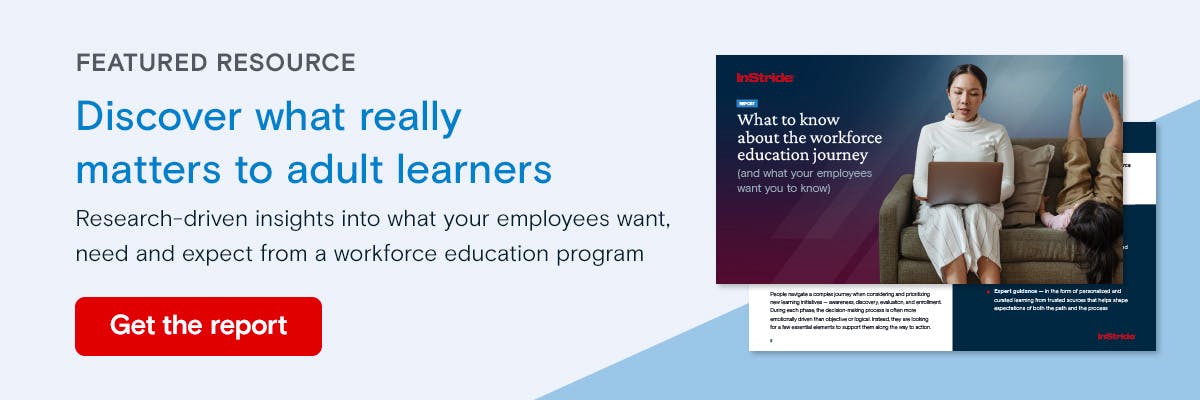Increasingly, learning and development (L&D) is earning recognition as a strategic driver of organizational growth and success. It’s easy to see why. Employee education and learning have proven to help increase retention, boost productivity, grow talent pipelines and reduce skills gaps. But providing employees with the content and resources to engage in learning is only one part of a greater effort. For L&D leaders (and employees) to reap these benefits, learning pathways are vital.
Engaging in an L&D initiative without a learning pathway is like driving to an unfamiliar location without a map. The experience can be enriching, but the journey may be unnecessarily longer than it needs to be. Plus, you’re likely to miss some vital mile markers that indicate that you’re on your way to your ultimate destination.
In the following, you’ll discover the advantages and fundamental building blocks of learning pathways, along with expert insights on how to maintain and adapt them for sustained organizational growth and employee advancement.
What is a learning pathway?
A learning pathway is a map or itinerary that serves as a guide for an employee’s learning journey. Often, this includes a series of learning activities that are strategically selected to lead to a desired professional development outcome. A pathway can support both ladder-like and lattice-like career progression.
The activities included in a learning pathway can be extremely granular, such as noting different actions required to build a new skill, or they can be more long-term such as an outline of steps to move an individual from their current role into a more advanced position. In all scenarios, however, the learning pathway should consist of at least three essential components:
Let’s look at a healthcare example. For instance, it may start by bringing entry-level individuals to a Medical Assistant (MA) or Patient Care Technician role, then helping them attain their pre-licensure requirements for Nursing. Once they become a Registered Nurse (RN), learning pathways can support upward mobility to become a Nurse Leader, Nurse Practitioner or Nurse Educator.
Similarly, a learning pathway can also support lattice-like mobility. For example, helping a Medical Assistant who no longer wants to stay in a patient-facing role to make a lateral transition into a position in IT, Health Information Management, or Medical Billing and Coding.
Benefits for employees
Learning pathways deliver value to employees in various ways.
- Provide clarity and control: Learners gain an understanding of exactly what L&D milestones they need to hit along the path in order to achieve their desired career outcome. Additionally, with learning pathways, employees are empowered to take the reigns and have more control over their own development.
- Simplify an often arduous process: Learning can feel like a large task that’s daunting or overwhelming. A learning pathway breaks it down into smaller, more achievable stepping stones that keep employees motivated by providing a continual sense of accomplishment and progress.
- Ensure accountability: Pathways can be used to track progress and ensure accountability for both employees and managers.
Benefits for employers
Learning pathways also offer a number of benefits to managers and organizational leaders:
- Identify high-potential talent: Working with employees to build learning pathways is one effective way to identify high potential (HiPo) talent, both in the creation phase as well as the subsequent progress towards their end goals. An employee who understands the steps they need to take and do so consistently may be marked as a HiPo.
- Enable workforce and succession planning: Having easier means to identify your top talent also make constructing and feeding a leadership or other high-needs role pipeline simple. L&D leaders can work with HiPo employees to create learning pathways that prepare potential successors. By ensuring a smooth transition and maintaining continuity, companies can minimize disruptions, while maintaining organizational stability and growth.
- Drive L&D engagement: Using learning pathways to illustrate a clear road to better rewards is a great way to get more employees engaged with your L&D programs. Employees are much more likely to engage with L&D when options, such as learning pathways, are simplified for them and they can easily see tangible outcomes.
- Upskill and reskill to fill gaps: Leveraged on a continual basis, a learning pathway can fuel internal mobility by keeping an employee ahead of their own skills and competencies. However, it’s not just about promoting upward mobility. Learning pathways can also help employees make lateral moves into positions that feel more interesting or are better suited to their competencies.
The building blocks of an employee learning pathway
Here are foundational elements to use as a starting point for constructing learning pathways for your business:
- Timeline: Establish an estimated timeline for completion. This can be tentative but it’s ideal to set deadlines for key milestones and take into account that some learning takes longer than others.
- Learning options: Lay out step-by-step exactly what’s required for an employee to gain the education needed for specific roles within your company. This involves curating the right mix of learning opportunities that can range from training, skills courses, professional certificates and high-school completion, to earning associate, bachelor’s and graduate degree programs.
- Other development opportunities: Make sure to arm your learners with the knowledge of additional opportunities for learning. These can include mentorships, stretch projects, company activities that support innovation (such as hackathons, etc.) or attending industry events.
- Flexibility: Learning is unique to the individual, thus pathways should be built to be flexible and able to evolve to fit individual needs. For example, two individuals in the same current position with the same goal could have different learning paths based on their backgrounds or levels of experience. There will be overlap, but there will also likely be some key differences.
- Goal or outcome: The importance of having a clear objective cannot be understated. By providing direction, a goal guides actions and enables progress toward meaningful outcomes. At the same time, be clear that you’re not guaranteeing that an employee will achieve their desired career outcome — such as, if you do X, you will get promoted. It’s simply a recommendation of what will help you gain the skills needed for the next level.
Similar to other L&D tactics, earning pathways are not a “set-it-and-forget-it” initiative. It requires continued maintenance to ensure your pathways stay useful and relevant. It’s also important to remember that learning is often a long-term investment that takes time to deliver measurable outcomes.
Supercharge L&D results by investing in learning pathways
Learning paths play a crucial role in an organization’s success by providing a structured framework to develop your employees’ skills and acquire new knowledge. We’ve covered the basics and the value. However, it’s essential to build logical, customized and efficient learning pathways that enable learners and companies to continually grow.
That’s where InStride comes in. At InStride, we do the heavy lifting for you. Leading organizations partner with InStride to develop tailored workforce education solutions with learning pathways that are strategically aligned to address your businesses' most pressing skills needs.
For more information, get in touch today.


